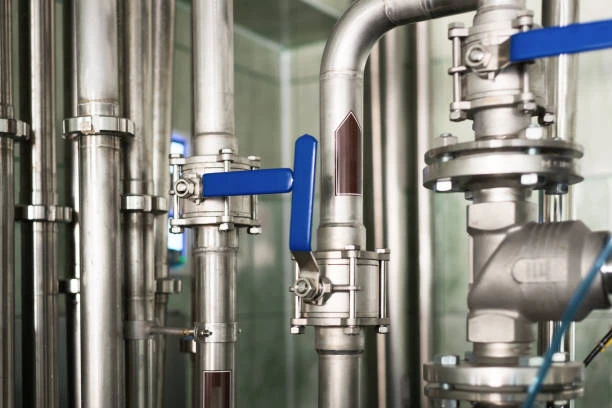Chlorine dioxide has gained attention in recent years as a powerful disinfectant, particularly in the treatment of drinking water. Its use in water distribution systems has raised important questions about its effects on various components, including distribution pipe fitting. This article will explore how chlorine dioxide interacts with hot and cold water distribution pipe fittings, the benefits and challenges of its use, and best practices for ensuring system integrity.
Understanding Distribution Pipe Fittings
Distribution pipe fittings play a critical role in water supply systems, connecting various sections of piping to facilitate the flow of water. These fittings come in various materials, including PVC, CPVC, copper, and stainless steel, each offering different advantages and disadvantages. Understanding the compatibility of these materials with chlorine dioxide is essential for maintaining the efficiency and safety of water distribution systems.
What is Chlorine Dioxide?
Chlorine dioxide (ClO2) is a chemical compound commonly used as a disinfectant in water treatment processes. It is effective in eliminating bacteria, viruses, and other pathogens, making it a preferred choice for ensuring safe drinking water. Unlike chlorine, chlorine dioxide does not form harmful disinfection byproducts (DBPs) when it reacts with organic matter, making it an environmentally friendly option for water treatment.
Effects of Chlorine Dioxide on Distribution Pipe Fittings
1. Material Compatibility
The interaction of chlorine dioxide with different pipe fitting materials is a critical consideration for water distribution systems:
- PVC and CPVC Fittings: Chlorine dioxide is generally compatible with PVC and CPVC materials. However, prolonged exposure to high concentrations may lead to degradation over time. It is essential to monitor chlorine dioxide levels to avoid potential damage.
- Copper Fittings: Chlorine dioxide can corrode copper fittings if present in high concentrations. Copper is sensitive to oxidative agents, and continuous exposure can lead to pitting and other forms of corrosion.
- Stainless Steel Fittings: Stainless steel fittings are more resistant to chlorine dioxide compared to other materials. However, the presence of chlorine dioxide can still contribute to stress corrosion cracking under certain conditions.
2. Impact on Pipe Integrity
The integrity of distribution pipe fittings is crucial for maintaining water quality and system efficiency. Chlorine dioxide can affect pipe integrity in the following ways:
- Corrosion: While chlorine dioxide is effective in disinfection, its oxidative properties can contribute to the corrosion of certain materials. Monitoring the concentration and exposure duration is vital to mitigate these effects.
- Scaling: Chlorine dioxide can help reduce biofilm formation within pipes, which can lead to scaling and blockages. This is beneficial for maintaining flow rates and reducing maintenance requirements.
- Mechanical Properties: Prolonged exposure to chlorine dioxide can affect the mechanical properties of certain materials. Regular inspection and maintenance are essential to ensure that fittings can withstand operational pressures.
3. Temperature Considerations
The effects of chlorine dioxide can vary based on water temperature:
- Hot Water Systems: In hot water distribution pipe fitting systems, the increased temperature can accelerate the chemical reactions involving chlorine dioxide. This can lead to faster degradation of susceptible materials, particularly copper.
- Cold Water Systems: Chlorine dioxide is less reactive at lower temperatures, making cold water systems generally more resilient to its effects. However, regular monitoring is still essential to prevent any potential issues.

Benefits of Using Chlorine Dioxide
Despite the potential challenges, the use of chlorine dioxide in water distribution systems offers several advantages:
- Effective Disinfection: Chlorine dioxide is highly effective in eliminating pathogens, ensuring safe drinking water for consumers.
- Reduced DBPs: Unlike traditional chlorine, chlorine dioxide does not produce harmful disinfection byproducts, making it a safer choice for water treatment.
- Biofilm Control: Chlorine dioxide can effectively reduce biofilm formation in pipes, leading to improved water quality and reduced maintenance needs.
Best Practices for Using Chlorine Dioxide in Distribution Systems
To maximize the benefits of chlorine dioxide while minimizing its impact on distribution pipe fittings, consider the following best practices:
- Material Selection: Choose pipe fittings that are compatible with chlorine dioxide and suitable for the specific water temperature and pressure conditions.
- Concentration Monitoring: Regularly monitor chlorine dioxide concentrations in the system to prevent corrosion and degradation of materials.
- Routine Inspections: Conduct routine inspections of pipe fittings to identify signs of corrosion or damage. Early detection can prevent costly repairs.
- Temperature Control: Maintain appropriate water temperatures in both hot and cold distribution systems to minimize the potential for chemical reactions.
- Training and Awareness: Ensure that personnel involved in water treatment and maintenance are trained in the use of chlorine dioxide and aware of its effects on materials.
Conclusion
Chlorine dioxide is an effective disinfectant for water distribution systems, but its interaction with various pipe fitting materials requires careful consideration. By understanding the effects of chlorine dioxide on distribution pipe fittings, water treatment facilities can implement best practices to maintain system integrity while ensuring safe drinking water for consumers. With proper monitoring and material selection, the benefits of chlorine dioxide can be fully realized without compromising the performance of distribution systems.
Frequently Asked Questions (FAQs)
- What is chlorine dioxide, and why is it used in water treatment?
Chlorine dioxide is a chemical disinfectant used to eliminate pathogens in water, offering effective disinfection without forming harmful byproducts. - How does chlorine dioxide affect different types of pipe fittings?
Chlorine dioxide can corrode certain materials, such as copper, while being generally compatible with PVC and CPVC. Its impact varies with temperature and concentration. - What are the benefits of using chlorine dioxide in water distribution systems?
Benefits include effective pathogen elimination, reduced disinfection byproducts, and control of biofilm formation in pipes. - How can I ensure the integrity of my distribution pipe fittings when using chlorine dioxide?
Regular monitoring of chlorine dioxide concentrations, routine inspections, and proper material selection are essential for maintaining fitting integrity. - Are there any alternatives to chlorine dioxide for water disinfection?
Yes, alternatives include traditional chlorine, ozone, and ultraviolet (UV) light, each with its own advantages and limitations.


















